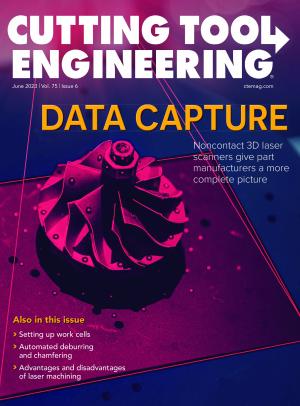A state-of-the-art waterjet cutting system is designed to offer advanced technology while being easier on operators than other systems of its kind.
Manufactured by Omax Corp. in Kent, Washington, the OptiMax is billed as an accurate, efficient, general-purpose cutting machine. The company also touts the system’s improved automation, which is aimed at making the OptiMax exceptionally user-friendly and maximizing uptime.
“A lot of work was done to automate the OptiMax as much as possible,” said Arion Vandergon, waterjet product marketing manager at Omax’s parent company, Hypertherm Inc., which does business as Hypertherm Associates.
An example of this is the technology behind the operation of the system’s direct-drive pump, called the EnduroMax.
“A lot of competitive waterjet systems rely on operators to tweak the software parameters or pump settings to optimize (the flow of) high-pressure water going out to the cutting head,” Vandergon said.
By contrast, the EnduroMax features automatic pressure control.
“You set the pressure you want,” Vandergon said, “or the system will default to the optimum pressure, and then the pump takes care of everything else.”
During cutting operations, he explained, a closed-loop pressure-control circuit monitors pump pressure and the speed of the motor is adjusted automatically when necessary to maintain exactly the right pressure.

“That’s going to ensure that parts come off the table with consistency,” Vandergon said.
Another key feature of the OptiMax is its IntelliTrax drive system, which includes a traction drive mechanism that moves a carriage along a rail, as well as a magnetic linear encoder and an electronic drive control for accurate positioning.
In addition, Omax touts IntelliTrax as the first motion control system designed specifically to deal with the abrasive material that mixes with water in waterjet cutting.
If abrasive gets into conventional ballscrew or rack-and-pinion waterjet drive systems, “it can cause significant damage,” Vandergon said. “But this patented design is virtually immune to any abrasive contamination.”
The OptiMax traction drives are fully enclosed to protect them from abrasive dust and water, and they require no lubrication. Omax points out that in abrasive environments, lubricated drive surfaces eventually are covered with fine abrasive dust that causes component wear and premature failure, as well as loss of accuracy.
Vandergon said one of the most common problems that waterjet operators have to deal with is abrasive clogging, which typically requires them to stop the cut, disassemble the abrasive hopper, clean out the clogged abrasive feed line with compressed air and finally reassemble the hopper. So the OptiMax’s new delivery system for garnet abrasive includes a patented feature called Air Sweep. When a clog occurs, operators can go into the OptiMax software and click “Purge,” which initiates an automated sequence that clears the line with compressed air. Then water is pumped through the waterjet nozzle to ensure that there are no remaining obstructions. He said this line-clearing sequence usually takes five to 10 seconds and necessitates no disassembly, which can save significant time when a clog develops.
Also included in the new garnet delivery system is a 3D-printed fluid diverter on the bottom side of the abrasive hopper that allows abrasive to drop out of the hopper but does not let water in the line flow up into the hopper.
An optional OptiMax feature that can make a substantial difference in the system’s cutting accuracy is Omax’s Tilt-A-Jet taper compensation head. As the name suggests, the Tilt-A-Jet tilts the waterjet nozzle at an angle calculated by the system software that offsets the natural taper of a waterjet cut. Vandergon explained that this taper is caused by the fact that the energy of a waterjet is greatest at the top surface of a part and then diminishes slightly as the jet cuts into the material.
The taper can be as little as 2 degrees, he said, “but for something like a tap-ready hole, you need to get rid of all of it. This head tilts just slightly to tilt the jet and remove that taper.”
Vandergon said the OptiMax can be found at job shops all over the world, as well as at facilities that manufacture parts for the aerospace industry.
“In a job shop, they could be using it to cut 0.25" mild steel one day and 3" aluminum the next day,” he said. “And in aerospace, it’s used a lot with composites for things like trimming operations and near-net-shape machining. So it’s really kind of an all-in-one tool.”
Contact Details
Related Glossary Terms
- abrasive
abrasive
Substance used for grinding, honing, lapping, superfinishing and polishing. Examples include garnet, emery, corundum, silicon carbide, cubic boron nitride and diamond in various grit sizes.
- composites
composites
Materials composed of different elements, with one element normally embedded in another, held together by a compatible binder.
- feed
feed
Rate of change of position of the tool as a whole, relative to the workpiece while cutting.
- waterjet cutting
waterjet cutting
Fine, high-pressure (up to 50,000 psi or greater), high-velocity jet of water directed by a small nozzle to cut material. Velocity of the stream can exceed twice the speed of sound. Nozzle opening ranges from between 0.004" to 0.016" (0.l0mm to 0.41mm), producing a very narrow kerf. See AWJ, abrasive waterjet.









